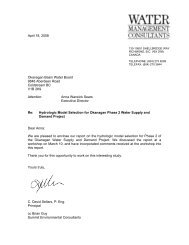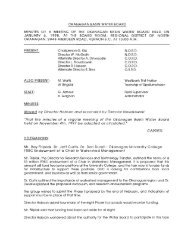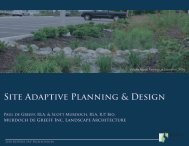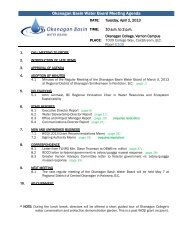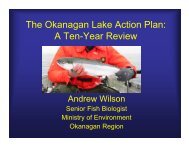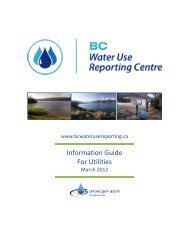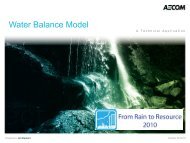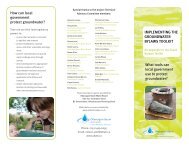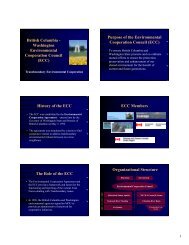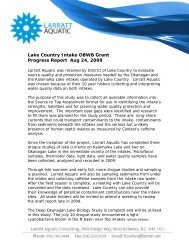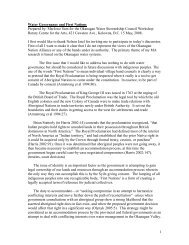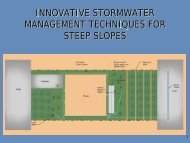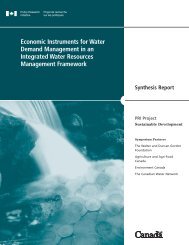Instream Flow Needs Analysis - Okanagan Basin Water Board
Instream Flow Needs Analysis - Okanagan Basin Water Board
Instream Flow Needs Analysis - Okanagan Basin Water Board
- No tags were found...
You also want an ePaper? Increase the reach of your titles
YUMPU automatically turns print PDFs into web optimized ePapers that Google loves.
FINAL<strong>Okanagan</strong> <strong>Basin</strong> <strong>Instream</strong> <strong>Flow</strong> <strong>Needs</strong>- Determination of instream flow needs and water level requirements (e.g., in lakes andthe mainstem <strong>Okanagan</strong> River) for fish and other key indicator species in <strong>Okanagan</strong>nodes. Salmonid fishes of management concern in the <strong>Okanagan</strong> were the focus, butconsideration was also given to aquatic “species of concern” meeting criteria under eitherCanada’s Species at Risk Act or BC Conservation Centre “sensitive or threatened”species lists.- Determination of instream flow requirements that meet general geomorphic and offchannelconnectivity functions.- Establishment of relationships among watershed conservation flows, optimum flows forfish, and critical period stream flows for aquatic biota.- Recognition of the existence of legal agreements at <strong>Okanagan</strong> nodes (conservation flowlicences and negotiated instream flows agreements).- Identification of uncertainties inherent in the recommended IFN analysis methods, data orindicators.- Establishment of an index for determining risk of individual nodes failing to meet IFNsfor aquatic biota.3. Generation of recommended weekly instream flow needs (IFN) for the 1996-2006 period for thesubset of surface nodes with permanent flowing water in the <strong>Okanagan</strong> <strong>Basin</strong>.4. Upload of all data and related metadata from this project to the <strong>Okanagan</strong> <strong>Water</strong> Database(Ok<strong>Water</strong>DB)—the master database that has been built to house daily or weekly values of thevarious water supply and demand variables developed during Phase 2 of the <strong>Water</strong> Supply andDemand Project.Our methodology for realizing these objectives is described in section 2.The potential spatial scope of this project involved a total of 81 key locations (“nodes”) within the<strong>Okanagan</strong> <strong>Basin</strong> that have been defined by the <strong>Okanagan</strong> <strong>Water</strong> Supply and Demand Study WorkingGroup. These nodes consist of key tributaries (at their mouths), mainstem lakes, and key locations on the<strong>Okanagan</strong> River mainstem (Figure 1.1). <strong>Water</strong> balance equations have been developed for each type ofnode. These equations identify the key water supply and demand terms that govern water inputs, outputs,and changes in storage at each node. Of this total, a subset of 45 locations were identified by the <strong>Instream</strong><strong>Flow</strong> Technical Committee that had permanent, year round flow and were considered definitely or likelyto support fish populations. These represented the initial node locations considered within our IFNanalyses. Lake nodes and nodes for the <strong>Okanagan</strong> River mainstem were further removed from this subsetlist as these nodes do not (at least currently) have naturalized flow data that we can use as inputs for IFNcalculations (although flow needs for these nodes may be addressed by other operating rules in place forthe <strong>Okanagan</strong> River). A final total of 36 tributary stream nodes in the <strong>Okanagan</strong> <strong>Basin</strong> were evaluatedwithin our IFN analyses.3 ESSA Technologies Ltd. &Solander Ecological Research



